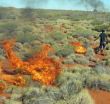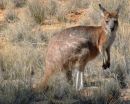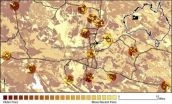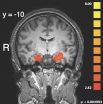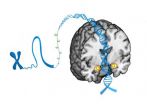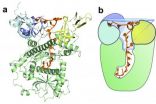(Press-News.org) SALT LAKE CITY, Aug. 4, 2014 – Australia's Aboriginal Martu people hunt kangaroos and set small grass fires to catch lizards, as they have for at least 2,000 years. A University of Utah researcher found such man-made disruption boosts kangaroo populations – showing how co-evolution helped marsupials and made Aborigines into unintentional conservationists.
"We have uncovered a framework that allows us to predict when human subsistence practices might be detrimental to the environment and when they might be beneficial," says Brian Codding, an assistant professor of anthropology.
"When subsistence practices have long histories, they are more likely to sustain ecosystem stability," he says. "But when there are sudden changes to the way people make a living on the land, expect the result to be detrimental to the environment."
The findings, published online today in the journal Human Ecology, suggest that Australia might want to encourage small-scale burning to bolster wildlife populations in certain areas, Codding says.
"In some parts of Australia where Aboriginal people no longer are burning the bush, ecologists are recording rapid declines in threatened species, which also might be due to increased predation by invasive predators," he adds.
The study concludes: "To be successful, management schemes should facilitate traditional burning and hunting regimes in remote communities, and incorporate this traditional ecological practice into future management protocols."
The new study found that small grass fires set by Martu to reveal sand monitor lizard holes created a patchy mosaic of five stages of vegetation at different post-fire ages, increasing hill kangaroo populations because the animals can hide from predators like dingoes in older bush grass and spend most of their time eating shoots and fruits in patches of younger vegetation. Counts of kangaroo scats showed kangaroo populations were largest at moderate distances from Martu settlements. At those distances, there also were moderate levels of both kangaroo hunting and burning to expose lizard burrows.
"As people spend more time hunting in a region, kangaroos densities actually increase, but only up to a threshold, after which their populations decline," Codding says.
Martu-set fires average about 10 acres – a small fraction of the size of fires ignited by lightning, Codding says, noting that patchy vegetation created by intentional fires reduce the likelihood of devastating, large blazes.
The research was done by Codding, the first and corresponding author, and by three other anthropologists: his former doctoral advisors at Stanford University – senior author Douglas Bird and his spouse Rebecca Bliege Bird – and Peter Kauhanen, formerly of Stanford and now at the San Francisco Estuary Institute. The research was funded by the National Science Foundation and Stanford's Woods Institute for the Environment.
An earlier study by the same researchers showed Martu-set fires increase sand monitor lizard populations, despite the negative impact of hunting. And there are indications mammals like brushtail possums and hare-wallabies also benefit.
Unintentional Conservationists and the Dreamtime
Codding and colleagues conducted the study in a 60-by-35-mile area within western Australia's Little Sandy Desert, where the native Martu people hold title to a vast expanse of land. The study area was centered on the community of Parnngurr, which has about 100 residents but can swell to 500 during ritual and sporting events.
"People have been living in this region for more than 35,000 years, but we're not sure how long people have used fire to modify the landscape," Codding says. "Recent evidence suggests Aboriginal fires have been occurring for the past 2,000 to 4,000 years."
Martu, usually women, set small fires in spinifex grass – the dominant vegetation – during wintertime hunts to expose burrows occupied by 2-foot-long sand monitor lizards, or sand goannas, which they drag out of the holes, kill and roast for food.
"They're a great meal, a very reliable food source," Codding says. "It's tender white meat, but not like chicken. It's like sand monitor lizard."
Martu men drive along dirt four-wheel-drive tracks to different hunting areas. There, they use .22-caliber rifles to hunt hill kangaroos, a midsized species (3 feet to 5 feet long) named Macropus robustus, also known as the euro or common wallaroo. They live in grass and bush in rocky areas and ridges surrounding eucalyptus- and acacia-dotted, grassy sand plains, where they forage. They rarely travel more than 3 miles from home.
Codding says co-evolution "is how two or more species interact with one other, directly or indirectly, over time in ways that alter each other's evolution" – an ecological mechanism that he says explains how moderate levels of burning by the Martu actually bolsters kangaroo populations.
Conservation means paying a cost for a long-term benefit that helps everyone, and sustainable management implies intent and planning. The Martu do neither; they simply hunt and burn bush to obtain food to survive, Codding says.
"The 'conservation' of kangaroos is an outcome that evolved," he says. "It would be wrong to assume that Martu were intentionally managing a resource. As Martu have said, 'That's something white fellas do.' But they are well aware their fires benefit kangaroos and other wildlife. In fact, they see humans as part of a larger ecosystem that has spiritual components" – the dreamtime place of creation where ancestors roamed.
"The dreamtime is essentially law passed down from ancestor beings to prescribe how people behave, what rituals to perform and how things came to be," Codding says. "By hunting and lighting fires, the Martu are enacting the law passed down by dreamtime ancestors. So perhaps it's not surprising to them it has positive results for the ecosystem."
Kangaroo Populations Highest Where Human Disruption is Moderate
The study's key finding is that kangaroo populations are highest where human disruption is moderate, not most intense or minimal. In other words, the kangaroos are most abundant at moderate distances from the community – a 40- to 80-minute drive – where hunting is more common than in areas closer to the community and father from it. Indeed, kangaroo population levels close to the village – where they were hunted first – are the same as at great distances from the community, where there is little hunting and bush burning.
The study doesn't suggest that hunting kangaroos helps the animals, but that any harm to kangaroo populations by hunting is outweighed by what they gain from a landscape with small patches of different ages of post-fire vegetation. It's just that the Martu tend to hunt kangaroos in the same areas where they burn the grass to hunt lizards.
Codding says the new study looked at kangaroo populations in all five stages of post-fire spinifex grass vegetation, as described by the Martu.
The first is Nyurnma, or bare ground; second is Waru-Waru, or early regrowth starting six months to a year post-fire; and third is Nyukura, the middle stage that begins one to five years after fire and features fruits such as bush tomato and bush raisin eaten by the Martu and hill kangaroos. The two final stages occur five to 15 years after fire: Manguu, when spinifex grass forms hummocks and re-establishes dominance, and Kunarka, dominated by old spinifex grass hummocks decaying at the center.
To conduct the study, Codding and colleagues followed Martu people on 50 hunts during 2007-10 and estimated how much time they spent hunting in each of 15 traditional hunting areas around Parnngurr.
"We went hunting with people and recorded the amount of time they spent hunting for different things (including lizards and kangaroo) and foraging for bush fruits," Codding says. The researchers also monitored how long Martu hunters were away from their camps and what they brought back from the hunts.
They also walked two predetermined 0.6-mile lines in each hunting area, counting the density of kangaroo scat in patches of vegetation in each of the different post-fire growth stages. And they used satellite images and on-the-ground measurements of the patchiness of different stages of post-fire vegetation from November 1999 to April 2010.
INFORMATION:
University of Utah Communications
75 Fort Douglas Boulevard, Salt Lake City, UT 84113
801-581-6773 fax: 801-585-3350
http://www.unews.utah.edu
Kangaroos win when Aborigines hunt with fire
Co-evolution benefits Australia's Martu people and wildlife
2014-08-04
ELSE PRESS RELEASES FROM THIS DATE:
New trick for 'old' drug brings hope for pancreatic cancer patients
2014-08-04
Cancer Research UK scientists have found a new use for an old drug by showing that it shrinks a particular type of pancreatic cancer tumour and stops it spreading, according to research published in Gut*.
"It's a crucial step forward in developing new treatments for this devastating disease..." - Dr Jennifer Morton, study author
The scientists, at the Cancer Research UK Beatson Institute and the University of Glasgow, treated mice with pancreatic cancers caused by known genetic faults with the drug rapamycin**.
Previous clinical trials did not find this drug to be ...
Primary care telephone triage does not save money or reduce practice workload
2014-08-04
Demand for general practice appointments is rising rapidly, and in an attempt to deal with this, many practices have introduced systems of telephone triage. Patients are phoned by a doctor or nurse who either manages the problem on the phone, or agrees with the patient whether and how urgently they need to be seen.
A new large study, published in The Lancet on 4 August 2014 and funded by the UK National Institute for Health Research (NIHR), has investigated the potential value of telephone triage for patients and for the NHS. It concluded that patients who receive a telephone ...
Tumor suppressor mutations alone don't explain deadly cancer
2014-08-03
Although mutations in a gene dubbed "the guardian of the genome" are widely recognized as being associated with more aggressive forms of cancer, researchers at the University of California, San Diego School of Medicine have found evidence suggesting that the deleterious health effects of the mutated gene may in large part be due to other genetic abnormalities, at least in squamous cell head and neck cancers.
The study, published online August 3 in the journal Nature Genetics, shows that high mortality rates among head and neck cancer patients tend to occur only when mutations ...
Atlantic warming turbocharges Pacific trade winds
2014-08-03
New research has found rapid warming of the Atlantic Ocean, likely caused by global warming, has turbocharged Pacific Equatorial trade winds. Currently the winds are at a level never before seen on observed records, which extend back to the 1860s.
The increase in these winds has caused eastern tropical Pacific cooling, amplified the Californian drought, accelerated sea level rise three times faster than the global average in the Western Pacific and has slowed the rise of global average surface temperatures since 2001.
It may even be responsible for making El Nino events ...
Uncovering the 3-D structure of a key neuroreceptor
2014-08-03
Neurons are the cells of our brain, spinal cord, and overall nervous system. They form complex networks to communicate with each other through electrical signals that are carried by chemicals. These chemicals bind to structures on the surface of neurons that are called neuroreceptors, opening or closing electrical pathways that allow transmission of the signal from neuron to neuron. One neuroreceptor, called 5HT3-R, is involved in conditions like chemotherapy-induced nausea, anxiety, and various neurological disorders such as schizophrenia. Despite its clinical importance, ...
Fault trumps gruesome evidence when it comes to punishment
2014-08-03
Issues of crime and punishment, vengeance and justice date back to the dawn of human history, but it is only in the last few years that scientists have begun exploring the basic nature of the complex neural processes in the brain that underlie these fundamental behaviors.
Now a new brain imaging study – published online Aug. 3 by the journal Nature Neuroscience – has identified the brain mechanisms that underlie our judgment of how severely a person who has harmed another should be punished. Specifically, the study determined how the area of the brain that determines ...
Small DNA modifications predict brain's threat response
2014-08-03
DURHAM, N.C. -- The tiny addition of a chemical mark atop a gene that is well known for its involvement in clinical depression and posttraumatic stress disorder can affect the way a person's brain responds to threats, according to a new study by Duke University researchers.
The results, which appear online August 3 in Nature Neuroscience, go beyond genetics to help explain why some individuals may be more vulnerable than others to stress and stress-related psychiatric disorders.
The study focused on the serotonin transporter, a molecule that regulates the amount of ...
Knowing what to keep and what to trash: How an enzyme distinguishes cellular messages
2014-08-03
Cold Spring Harbor, NY – Every once in a while, we are forced to sort that stack of papers on the kitchen counter. Interspersed between the expired coupons and dozens of takeout menus are important documents like your car insurance or electric bill. So it isn't an option to simply drop it all in the trash at once – you need to read through the messages to be sure that you don't lose vital information.
In the cell, proteins similarly read through messages to distinguish what needs to be saved and what needs to be discarded. But, here, the process takes on a much more ...
Atlantic origin of recent Pacific trade wind, sea level and temperature trends
2014-08-03
An Australian–US team of climate researchers has solved a puzzle that has challenged scientists for over a decade. Climate models predict that the equatorial Pacific trades should weaken with increasing greenhouse gases. Yet, since the early 1990s, satellites and climate stations reveal a rapid and unprecedented strengthening of the Pacific trade winds, accelerating sea level rise in the western Pacific and impacting both Pacific and global climate.
"The answer to the puzzle is that recent rapid Atlantic Ocean warming has affected climate in the Pacific," say the scientists. ...
Self-assembling anti-cancer molecules created in minutes
2014-08-03
Researchers have developed a simple and versatile method for making artificial anti-cancer molecules that mimic the properties of one of the body's natural defence systems.
The chemists, led by Professor Peter Scott at the University of Warwick, UK, have been able to produce molecules that have a similar structure to peptides which are naturally produced in the body to fight cancer and infection.
Published in Nature Chemistry, the molecules produced in the research have proved effective against colon cancer cells in laboratory tests, in collaboration with Roger Phillips ...
LAST 30 PRESS RELEASES:
Bluey’s dad offered professorial chair in archaeology at Griffith University
Beyond small data limitations: Transfer learning-enabled framework for predicting mechanical properties of aluminum matrix composites
Unveiling non-thermal catalytic origin of direct current-promoted catalysis for energy-efficient transformation of greenhouse gases to valuable chemicals
Chronic breathlessness emerging as a hidden strain on hospitals
Paleontologists find first fossil bee nests made inside fossil bones
These fossils were the perfect home for ancient baby bees
Not everyone reads the room the same. A new study examines why.
New research identifies linked energy, immune and vascular changes in ME/CFS
Concurrent frailty + depression likely boost dementia risk in older people
Living in substandard housing linked to kids’ missed schooling and poor grades
Little awareness of medical + psychological complexities of steroid cream withdrawal
Eight in 10 trusts caring for emergency department patients in corridors, finds BMJ investigation
NASA’s Webb telescope finds bizarre atmosphere on a lemon-shaped exoplanet
The gut bacteria that put the brakes on weight gain in mice
Exploring how patients feel about AI transcription
Category ‘6’ tropical cyclone hot spots are growing
Video: Drivers struggle to multitask when using dashboard touch screens, study finds
SLU research shows surge in alcohol-related liver disease driving ‘deaths of despair’
Rising heat reshapes how microbes break down microplastics, new review finds
Roots reveal a hidden carbon pathway in maize plants
Membrane magic: FAMU-FSU researchers repurpose fuel cells membranes for new applications
UN Member States pledge to increase access to diagnosis and inhaled medicines for the 480 million people living with COPD
Combination therapy shows potential to treat pediatric brain cancer ATRT
Study links seabird nesting to shark turf wars in Hawai‘i
Legal sports betting linked to sharp increases in violent crime, study finds
Breakthrough AI from NYUAD speeds up discovery of life-supporting microbes
New Eva Mayr-Stihl Foundation funding initiative boosts research at University of Freiburg on adaptation of forests to global change
The perfect plastic? Plant-based, fully saltwater degradable, zero microplastics
Bias in data may be blocking AI’s potential to combat antibiotic resistance
Article-level metrics would provide more recognition to most researchers than journal-level metrics
[Press-News.org] Kangaroos win when Aborigines hunt with fireCo-evolution benefits Australia's Martu people and wildlife
